Check out my custom vibration dampener
Wilson Pro Staff 97 v13
Detailed Review & Playtest + Video
We hope you love this article. Just so you know, TennisCompanion may collect a small share of sales from the links on this page to help keep this site running. Learn more. Disclosure: Wilson gave me this frame to evaluate, but they did not pay me to write this review or influence its contents.
All-new for 2020, the Wilson Pro Staff 97 v13 is a welcome update to this popular frame, one of the game’s control-centric racquets.
Unlike it’s bigger brother, the RF97 v13, which specs remain the same as the prior generation and only receives an upgraded design, the Pro Staff 97 is an exciting refresh for what it adds and removes.
For this review and playtest, I’m diving deep to examine the specs and technologies while explaining how it differs from the prior model. I’ll also hit the court to showcase how the Pro Staff 97 v13 performs and share my experience, so you’ll know what to expect from this iconic frame.
| Pro Staff Models |
| Wilson Pro Staff RF97 |
| Wilson Pro Staff 97 |
| Wilson Pro Staff 97L |
| Wilson Pro Staff 97UL |
You can also pick up the racquet on Wilson’s website, and they have an excellent demo program you can use to try the racquet before making a decision.
Article Contents
Click below to jump to a section
Tap below to jump to a section
Video Review & Playtest
About the Pro Staff 97 v13
Specs & Technologies
Pro Staff Models
Design & Aesthetics
Players Endorsing
Strings & Tension
Review & Playtest Notes
Summary & Takeaways
New to TennisCompanion?
Create a free account and explore my latest videos below
Video Review & Playtest for the Pro Staff 97 v13
If you’d prefer, you can check out my full video review and playtest of the Pro Staff 97 v13. Not only will you get to see the racquet in action, but you’ll have some extra visuals to go along with my explanations.
Below you’ll find timestamps to various sections of the video so that you can quickly jump around or reference a specific part in the future.
0:00 Start
0:25 Intro
0:45 Specs
0:58 Length, Head Size, String Pattern
1:08 Weight
1:33 Swingweight
1:36 Balance
1:47 Stiffness
1:52 Beam
1:59: Technologies
2:22 Braid 45
2:48 String Mapping
3:05 Perimeter Weighting System
3:25 Design & Aesthetics Start
4:35 Strings & Tension
4:43 Playtest String Setup
5:37 Playtest
5:55 Playtest Notes
6:01 Groundstrokes
6:57 Volleys
7:31 Serves
8:09 Returns
8:42 Summary
9:29 vs. Pro Staff 97 w/ Countervail
10:09 vs. Pro Staff Rf97 v13
11:00: Wrapping Up
You’ll find a bit more detail in this written version, but they pair nicely to answer all your questions about this tennis racquet. Enjoy!
About the Pro Staff 97 v13

Released on September 14, 2020, the Pro Staff’s thirteenth generation is a welcome update to Wilson’s ever-popular family of racquets, emphasizing precision and control.
The frame has an illustrious history, which began back in 1983. Wilson can credit 117 Grand Slam titles to the racquet, whos past champions include Pete Sampras, Steffi Graff, Stefan Edberg, and Chris Evert.
These days, Roger Federer continues the Pro Staff’s legacy, having used it from the start of his professional career in 1998. Although he now has a signature model, Federer has worked closely with Wilson to help evolve and refine the Pro Staff line for the modern game.
Beyond the frame’s impressive credentials, it’s become a cult favorite among competitive players from club to college who appreciate the classic feel that results from the time-tested formula of braided graphite, perimeter weighting system, thin beam, and head light balance.
For this model, Wilson removes Countervail, a somewhat controversial material added to the racquet’s layup in 2017. They’ve also updated the racquet’s graphite braid and tweaked the 16×19 string pattern, all of which we’ll cover as part of this review in greater depth.
From a design standpoint, the Pro Staff 97 v13 pays subtle tribute to the Pro Staff Original 6.0 while refining its modern and sleek aesthetic.
Hans-Martin Reh, GM at Wilson Racquet Sports, sums it up nicely.
“We never want to change any aspect of the racket unless we can do so in a meaningful way that gives our players a true advantage on the court. For the 2020 line, we brought forth new, advanced technologies to enhance Pro Staff’s playability and precision, while honoring the racket’s roots with cues from its iconic past and 117 Grand Slam wins.”
Of course, not all racquet innovations hit the mark, so keep reading to see whether the Wilson Pro Staff RF 97 v13 gets it right.
Comparing Wilson’s Performance Racquets
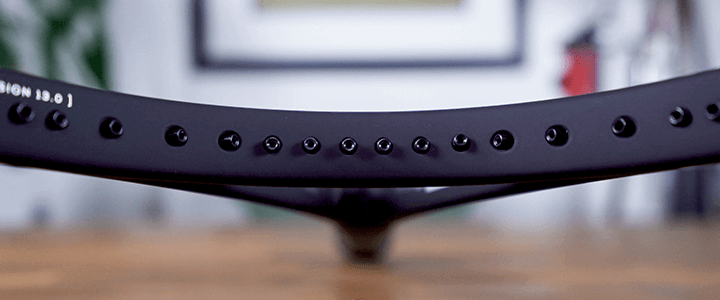
Although the Pro Staff is a fan favorite, it’s only one of a handful of purpose-built tennis racquet lines from Wilson designed to cater to a wide variety of player needs and preferences.
Let’s take a quick look at what players should expect from each.
Pro Staff as a Baseline
The general heavier weight and exclusive 97 in² (626 cm²) head size of the Pro Staff line makes a statement that targets experienced players who demand a responsive control-oriented racquet.
Players who have honed their technique and have an all-court style of play will appreciate the Pro Staff’s well-rounded performance, which offers mid-range power and topspin with excellent precision and feel.
Pro Staff vs. Blade
In the broad scheme of tennis racquets, the Blade and the Pro Staff share many similarities, but generally speaking, the Blade will offer players with a bit less power and extra topspin, in a slightly lighter package.
However, what further distinguishes these two racquet lines is their feel. The Blade has a thinner beam, lower stiffness, and keeps more weight in the racquet’s head, for maximum flex, added feel, and comfort.
On the other hand, the Pro Staff shifts weight toward the handle, retains extra rigidity and plays a bit more lively.
Pro Staff vs. Ultra
While the Pro Staff delivers exceptional precision and control, the Ultra provides explosive power, managed through heavy topspin and well suited to the modern power-baseline style of play.
The Ultra line is lighter and offers a more generous 100 in² (645 cm²) head size, making it more approachable than the Pro Staff. It swings fast and plays crisp and lively, so players with a history or arm discomfort or injuries will want to proceed with caution.
Pro Staff vs. Clash
The Clash is a newer frame from Wilson that offers an innovative approach to materials and construction, which marries the control of a flexible racquet with a stiffer racquet’s power.
It’s far lighter and dramatically more flexible than the Pro Staff and offers more generous head sizes for added topspin. While the Pro Staff gears toward higher-level play, the Wilson Clash is an extremely user-friendly racquet that is ideal for players who desire the utmost comfort.
Pro Staff 97 v13 Specs & Technologies

The 2020 Pro Staff 97’s specs and technologies combine for a racquet that’s responsive, yet delivers exceptional control.
Let’s start by looking at the racquet’s specifications, which are useful to gain a sense of what to expect. However, while helpful for comparison, they won’t tell you how a racquet will feel, so I encourage players to demo a racquet whenever possible.
| Spec | Measurement |
| Head Size | 97 in² / 625.81 cm² |
| Length | 27 in / 68.58c m |
| Strung Weight | 11.7 oz / 333 g |
| Unstrung Weight | 11.1 oz / 315 g |
| Strung Balance | 7 pts HL / 32 cm |
| Unstrung Balance | 10 pts HL / 31.2 cm |
| Swingweight | 321 |
| Stiffness | 66 |
| Beam Width | 21.5 mm / 21.5 mm / 21.5 mm |
| Composition | Graphite & Kevlar |
| String Pattern | 16 Mains / 19 Crosses |
| String Tension | 50-60 pounds / 22.68-27.22 kg |
For the most part, the Pro Staff 97 specs remain very close to the prior generation from 2017. As you’d expect, the racquet offers a smaller 97 in² (626 cm²) head size and maintains it’s 27-inch length while also continuing with the 16×19 string pattern.
For its unstrung weight, Wilson markets the racquet at a somewhat heavier 11.1 ounces (315 grams), and although what ships often differ, my Pro Staff 97 came in spot on at 11.14 ounces or 315.6 grams.
Wilson hasn’t always had the greatest track record in hitting these specs, so it’s great to see that this particular offering is accurate.

A racquet’s strung weight will vary slightly depending on the strings you choose and its gauge, but the addition of 18 or so grams is usually fair, which puts this racquet’s strung weight at 11.7 ounces or 332 grams.
The Pro Staff 97 also has a swingweight of 321 and a balance of 10 pts HL at 31.2 cm unstrung. With strings installed, you’ll find the balance reduces a bit to 7 pts HL at 32cm.

A racquet’s stiffness measures how flexible the frame is and contributes to the racquet’s feel and power. The Pro Staff 97 has a mid-range RA or stiffness rating of 66.
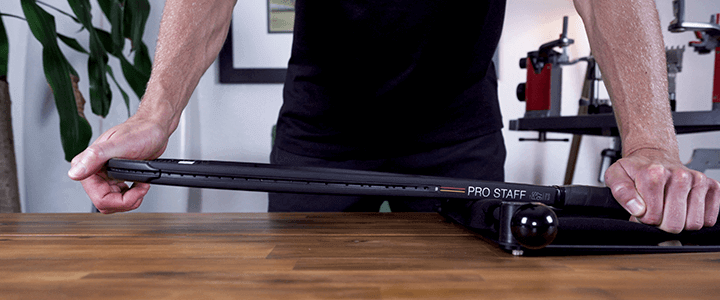
You’ll also find the racquet has a control-centric 21.5 mm beam.
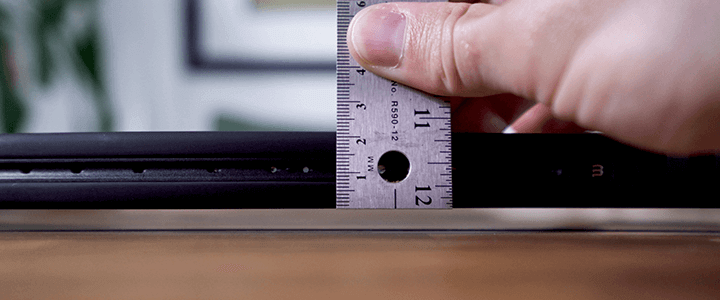
Pro Staff 97 v13 Technologies
For the thirteenth generation of the Pro Staff, you’ll find many familiar technologies players have come to expect from this line of racquets.
However, relative to the prior version, some crucial changes are worth noting, directly impacting the racquet’s feel and performance.
Countervail is History
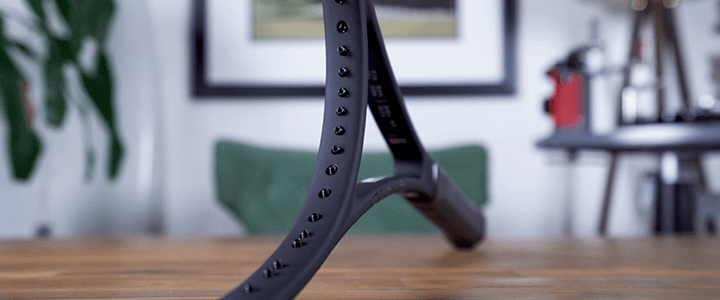
In 2017, Wilson updated the Pro Staff line and introduced a new technology called Countervail, which the aerospace and cycling industries had successfully implemented.
According to Wilson, Countervail intended to reduce player fatigue and improve comfort by reducing vibration passed to a player’s arm. Although their studies suggest improvements with this material, many players, including me, recognized a noticeable change in feel.
In essence, Countervail dampened the racquet’s feedback and subsequently reduced its feel. For some players with arm issues or discomfort, this type of change might be welcome. However, many others, who enjoy the classic Pro Staff feel weren’t fans of the update.
Players who fall into the latter camp will be happy to hear that the latest generation of the Pro Staff line no longer contains Countervail.
Braid 45 (Graphite + Kevlar)

The Pro Staff’s continuous braided graphite and Kevlar construction sits at the foundation of the racquet’s performance and feel, which has been in use since the Pro Staff Original 6.0.
Most racquets layer smaller sheets of graphite to form the produce their frames, which, although a perfectly acceptable approach, changes how the racquet feels and performs.
However, for the latest release of the Pro Staff 97, they’ve tweaked the construction. Now the graphite and Kevlar fibers braid together at a 45-degree angle for enhanced feel and ball pocketing.
String Mapping

The string pattern, which refers to the number of main and cross strings, along with the density or space between each string, directly influences a racquet’s performance – most notably topspin and control.
The Pro Staff 97 maintains its 16×19 string pattern for this release, but they’ve adjusted the string bed’s density by decreasing the space between them for a more tightly woven sweet spot.
String mapping intends to improve the racquet’s control and feel without giving up too much on the spin front.
Perimeter Weighting System
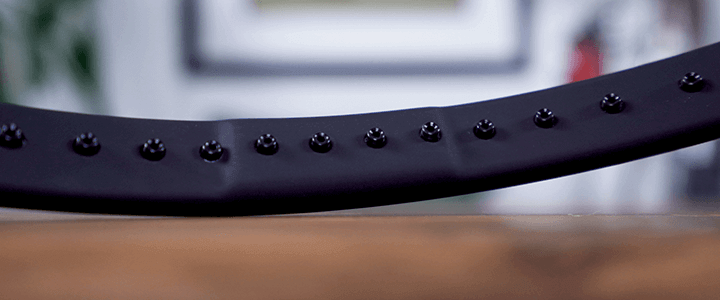
Another time-tested Pro Staff technology is Wilson’s Perimeter Weighting System (PWS), which strategically places extra weight at three and nine o’clock on the racquet’s head to reduce twisting and improve stability.
For the racquet’s thirteenth generation, the Pro Staff 97 retains this part of the formula, which gives the head a distinct style.
Weight, Balance, and Beam
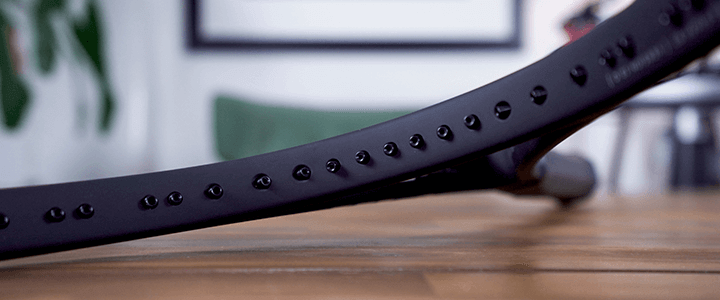
Last but not least, the Pro Staff 97 maintains it’s higher-end weight, significant head light balance, and relatively thinner beam, all of which combine with the technologies mentioned above to produce a feel that’s unique to this family of racquets.
Pro Staff v13 Models
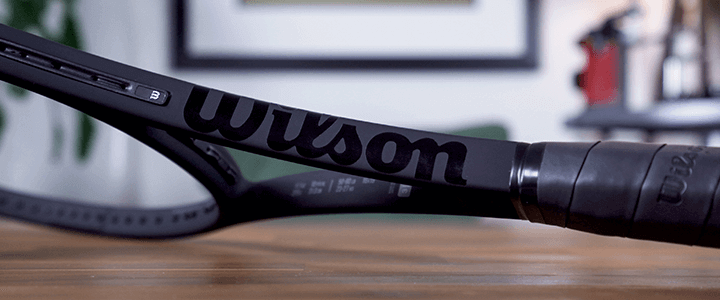
There are four distinct Pro Staff models available, which are primarily distinguished by their weight to appeal to a broader range of players.
Although many players gravitate toward the Pro Staff for its higher weight, not all players can comfortably swing the heaviest models. To this end, Wilson offers a few lighter versions to consider.
Pro Staff RF97 Autograph
The Pro Staff RF97 Autograph, Roger Federer’s signature racquet with specs that he uses on the court, is the heaviest model available.
It weighs in at 12 oz (340 g) unstrung, nearly a full ounce heavier than the Pro Staff 97. However, beyond its weight, this racquet does not use Wilson’s Braid 45 technology. Instead, the braided graphite construction remains unchanged, and the frame contains foam for dampening as the original Pro Staff models did.
Furthermore, the racquet features an all-black butt cap without rounded edges, and instead of a synthetic grip, it comes with leather.
Pro Staff 97
The Pro Staff 97 is a modern take on the RF97. It’s lighter, easier to handle, and features the upgraded technologies we’ve covered earlier, including Braid 45 and String Mapping.
Players intrigued by what racquet Roger Federer uses but find themselves intimidated by it’s higher weight and prefer a lighter weight option will want to consider this racquet, the most popular in the Pro Staff lineup.
Despite its lighter weight, the frame still falls on the heavier end of the spectrum when considering racquets more broadly.
Pro Staff 97L
Taking another step down in weight from the 97, the 97L or ‘light’ version of the Pro Staff is 10.2 oz (289g) unstrung, making it considerably more approachable and a reasonable entry point for many players.
It features the same technologies as the Pro Staff 97, but the lower weight means it will swing easier, which translates to better maneuverability for players that desire it.
However, Wilson also changes this racquet by increasing the beam width by 1.5 mm to 23 mm, which improves the racquet’s power by making the frame slightly more rigid or stiff. Weight influences a racquet’s power, so this change helps counteract the power loss.
Pro Staff 97UL
Finally, the Pro Staff 97UL or ‘ultralight’ rounds out the Pro Staff lineup for a frame with an entry-level weight.
Juniors transitioning to a full-length tennis racquet or adult beginners who might have started with an inexpensive racquet and are looking for an easy-to-swing premium frame will likely find what they’re looking for with this low-weight option.
At 9.5 oz (269g) unstrung, the 97UL is the lightest option in the Pro Staff family, which also features the thicker 23 mm beam that you’ll find on the 97L for a bit of extra power.
Pro Staff 97 v13 Design & Aesthetics
Wilson offers some of the cleanest racquet designs, and the Pro Staff line is no exception. The last version of this racquet from 2017 was available in a black and white tuxedo paint job and an all-black version.
For the thirteenth generation of this racquet, Wilson returns to the all-black design and replaces the gloss finish at three and nine o’clock on the racquet’s head with their velvet finish.
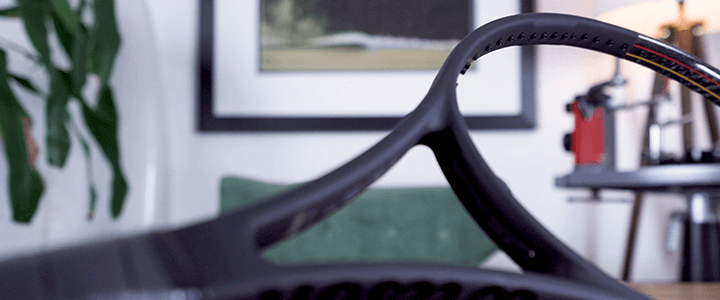
The racquet also pays tribute to the old-school Pro Staff Original 6.0 by adding subtle red and yellow racing stripes that complement the racquet’s modern aesthetic to give it a classic feel.

A new addition to the racquet’s design is the exposure of the frame’s braided graphite construction, which displays under a clear gloss finish while also continuing the red and yellow racing stripes.

On the inside of the racquet’s throat, you’ll find a few of the racquet’s specs, including its weight, balance, and recommended tension.

Finally, the racquet offers Wilson’s bold red butt caps with rounded edges to improve comfort. All in all, it’s a subtle yet refined update to an already great looking tennis racquet and one of my favorite designs.
Helpful Tip
The Pro Staff series of racquets no longer uses laser engraving.
Players looking to put their spin on the design should keep an eye on Wilson’s custom racquet center, where I expect the pain job will be customizable in the future.
Players Endorsing the Pro Staff 97 v13
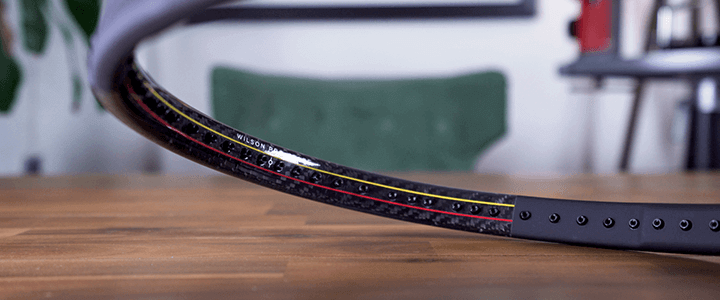
Although we can attribute Roger Federer’s use of the Pro Staff line throughout his career to the racquet’s continued popularity, he doesn’t endorse the Pro Staff 97. Instead, he uses the heavier RF97.
However, Federer’s not the only player endorsing the Pro Staff. Players on the ATP and WTA use the racquet. However, keep in mind that most professional tennis players customize their racquets, so although the players mentioned below are endorsing the Pro Staff, they’ve likely made additional customizations to suit their preferences.
Furthermore, many pros endorsing a specific frame use an older Pro Staff model, referred to as pro stock, which isn’t available to the public, but they paint to look like the racquet’s latest version. Wilson is forthright about this on their packaging, but it’s not always readily apparent.
It doesn’t diminish the latest model’s quality or performance, but it does highlight that pros don’t change racquets as frequently as one might expect purely based on racquets’ appearance.
| Men (ATP) | Women (WTA) |
| Roberto Bautista Agut | Petra Kvitova |
| Andreas Beck | Andrea Petkovic |
| Thomaz Bellucci | – |
| Steve Darcis | – |
| Juan Martin del Potro | – |
| Grigor Dimitrov | – |
| Kyle Edmund | – |
| Daniel Evans | – |
| Philipp Kohlschreiber | – |
| Dusan Lajovic | – |
| Leonardo Mayer | – |
| Reilly Opelka | – |
| Lukas Rosol | – |
| Bruno Soares | – |
Pro Staff 97 v13 Strings & Tension
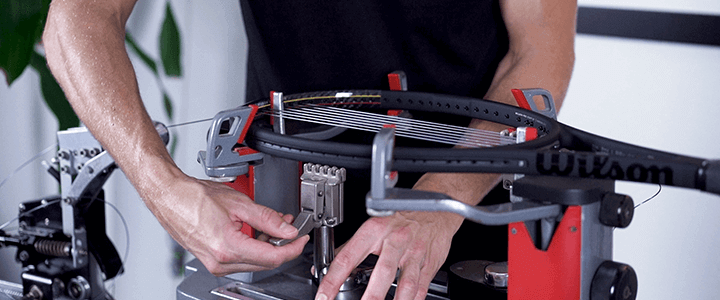
Wilson recommends a string tension between 50-60 pounds (22.7 – 27.2kg) for the Wilson Pro Staff 97 v13.
For my playtest, I strung the racquet with a full bed of Luxilon ALU Power 1.25 at 52 pounds, which is one of my favorite polyester tennis strings.

With the Pro Staff 97, a poly like ALU Power is a durable option that helps maximize the frame’s topspin and overall pairs nicely.
Although some players may opt for lower string tension, which polyester strings are well-suited for, I prefer to string a bit tighter, especially when hitting with a heavier frame.
I find the racquet’s mass provides more than enough string movement for excellent topspin, but I prefer a bit extra control.
Players looking for a bit extra comfort might consider opting for a hybrid string setup, which combines a multifilament with polyester to improve the racquet’s comfort without sacrificing too much on the topspin front.
Wilson Pro Staff 97 v13 Review & Playtest Notes
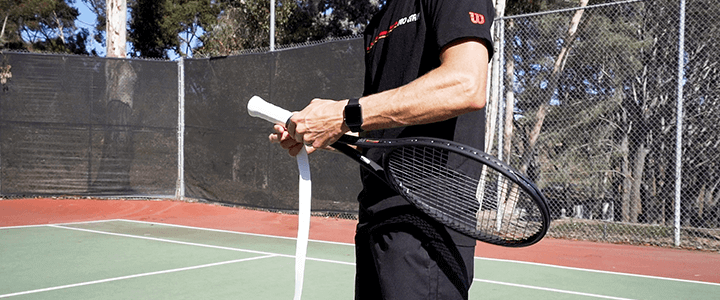
Unfortunately, all the specs, tech, and marketing can’t tell you how a racquet feels and performs. For that reason, I’ve put the Pro Staff 97 v13 to the test over the past few weeks.
In this section, you’ll find my thoughts and experience hitting with the racquet, which I hope helps serve as a useful reference point whether you’re considering this racquet or just curious what it has to offer.
| Main Strings | Luxilon ALU Power (1.25 mm) |
| Cross Strings | Luxilon ALU Power (1.25 mm) |
| Mains Tension | 52 lbs / 23.59 kg |
| Crosses Tension | 52 lbs / 23.59 kg |
| Forehand Grip | Semi-Western |
| Backhand | Two-handed |
| Grip Size | #3 – 4 3/8 |
| Grip | Wilson Pro Performance |
| Overgrip | Wilson Pro |
| Weight | 165 lbs / 74.84 kg |
| Height | 6’0″ / 1.83m |
To help make my experience and thoughts on the Pro Staff 97 v13 more concrete, I’ve rated the racquet on a set of criteria players typically find useful when evaluating a frame. Keep reading in the sections below for added context for how I arrived at each of these scores.
Groundstrokes

From the back of the court, I really enjoyed hitting with the Pro Staff 97. Despite its weight, the racquet swings with reasonable ease thanks to its head light balance while still leaving room for players to customize.
As you might expect from a Pro Saff, it’s a lively racquet that can deliver exceptional pace derived through sound technique. It won’t offer much free power, but plenty is on tap if you put in the effort.
Paired with a low-powered polyester, I found I could swing freely to maximize topspin while maintaining command over the ball.
Although not ideal for my game, which relies on heavier topspin, I think long-time Pro Staff users will appreciate the tightened up 16×19 string pattern, which trades a bit of topspin for a mild improvement to control.
Overall, I found this update and the new Braid 45 construction to improve the frame’s comfort and response, offering better ball pocketing without trading the crisp feel and excellent feedback you’d expect from a Pro Staff.
Volleys

At the net, the Pro Staff 97 is a solid overall performer.
The racquet’s head light balance makes it easy to maneuver, but it also has enough weight to absorb and redirect pace effectively.
I thought the frame delivered excellent feel and stability for precise targeting off both wings, which translates to added confidence.
As far as touch and finesse goes, I’d say this is another area where this generation improves. In many ways, we’re talking about subtle differences, but I felt in tune with the racquet’s consistent response, which added to an overall sense of control I had with it.
Serves

On serves, I thought the Pro Staff 97 held its own, and while it may underwhelm to a degree from a power standpoint, it makes up for it by delivering greater precision.
Once again, the racquet’s balance allows for excellent racquet head speed despite the frame’s heavier weight, so you can still generate plenty of pace when you need it, but you’ll have to work for it.
I did find the racquet’s new tighter string pattern to reduce its bite on slice and kick serves a bit, but I’d expect that to become insignificant after spending more time with the frame.
All in all, the Pro Staff 97 is more than sufficient on serves and an ideal fit for players who value accurate placement over power.
Returns

On returns, the Pro Staff 97 offers an ideal performance.
It’s maneuverable enough to quickly get the racquet into position while still retaining enough weight to stand up to the pace from a heavier serve.
Although the slightly tightened up string bed left me wanting a bit more topspin on groundstrokes, I found it worked well for me on returns offering extra control, especially with a more compact stroke.
Overall, I found the Pro Staff 97 to perform excellent hitting returns with depth and control while remaining stable and doing a fantastic job redirecting pace.
Summary & Takeaways
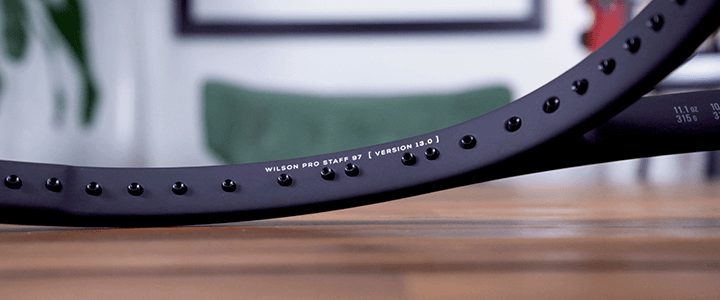
Catered toward intermediate to advanced players with an all-court style of play who value precision and control, the Pro Staff 97 v13 is a terrific frame and one of my picks for the best tennis racquets in 2022.
Not only does the racquet retain the time-tested lively feel and performance you’d expect from a Pro Staff, but Wilson’s Braid 45 and String Mapping technologies are welcome refinements that enhance rather than detract from the racquet’s formula.
Players with healthy arms looking to get the most out of the racquet’s excellent feedback and response will likely appreciate swapping out the synthetic grip for leather, which will add a small bit of extra weight too.
Although the modern and evolved Pro Staff 97 v13 will work well for various styles of play, aggressive baseliners who rely on maximum topspin and free power will likely want to look elsewhere.
| Pro Staff Models |
| Wilson Pro Staff RF97 |
| Wilson Pro Staff 97 |
| Wilson Pro Staff 97L |
| Wilson Pro Staff 97UL |
Pro Staff 97 v13 vs. RF97 v13

The most notable difference between the Pro Staff 97 and the RF97 is weight as the Pro Staff 97 is roughly an ounce or 25 grams lighter, making it easier to swing and maneuver while leaving room for personalized weight customization if desired.
Beyond weight, the Pro Staff 97 receives the upgraded Braid 45 construction and String Mapping tech while Federer’s signature model, the RF97, remains unchanged with identical specs to the prior version.
Additional nuances include the grip and butt caps. The Pro Staff 97 uses a synthetic grip and a red butt cap with rounded edges, while the RF97 uses a leather grip and a more traditional flat black butt cap.
All in all, they’ll both terrific options. However, I’m confident the update to the Pro Staff 97 will appeal to a broader audience than the RF97.
Pro Staff 97 v13 vs. Pro Staff 97 with Countervail
The last generation of the Pro Staff 97 incorporated Countervail into the graphite layup, which resulted in a somewhat muted feel and less feedback. In other words, it took a bit of the life out of the racquet.
Players who weren’t fans of Countervail will be happy to hear the Pro Staff 97 v13 removes it, so the racquet regains its lively feel and crisp response, but enhances it further with its Braid 45 construction.
Players who have wanted to upgrade but have held off should absolutely consider this model, which I expect to be a popular upgrade.
Why I Love It
- Control and precision
- Excellent feedback
- Stability
- All-court performance
Tradeoffs
- Lower power
- Less topspin
- Smaller sweet spot
Strings
The Pro Staff 97 is well-suited for a lower-powered polyester string setup. As a reminder, here’s what I used for my playtest:
- Mains: Luxilon ALU Power 1.25 at 52 lbs
- Crosses: Luxilon ALU Power 1.25 at 52 lbs
A poly like ALU Power allows players to take full cuts at the ball without compromising control and maximizing topspin. Here are a few additional of my favorite polys worth considering from a variety of brands:
- Solinco Confidential
- Volkl Cyclone
- Tecnifibre Ice Code
- Head Sonic Pro Edge
- Yonex Poly Tour Pro
- Babolat RPM Blast
Although I don’t get much durability out of the 1.25 guage, it’s a reasonable tradeoff with this frame for a bit extra bite and added feel, which you could buffer with string savers if you feel compelled.
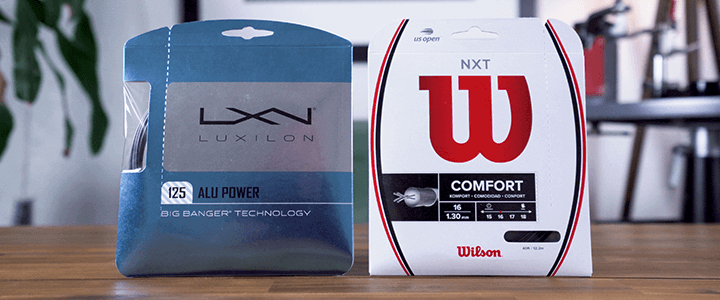
Players looking to enhance the Pro Staff 97’s moderate comfort might consider a hybrid string setup. The addition of a natural gut or a multifilament with polyester will soften up the string bed and add a bit extra power without giving up too much topspin.
Keep in mind that the string you choose for the mains will dominate the overall feel.
Bottom Line
The Wilson Pro Staff 97 v13 is one of my favorite updates to the Pro Staff line in years, which I expect will resonate with long-time enthusiasts.
The racquet has a higher-end weight, but its head light balance retains excellent usability, which is well-suited for intermediate to advanced players with an all-court style that relies on precision and control.
Wrapping Up
A huge thank you to Wilson for sending me the Pro Staff 97 v13 ahead of its release. I enjoyed the opportunity, and I hope my thoughts and experience with the racquet help guide your decision making.
If possible, I’d encourage players to consider trying or demoing the racquet before buying. However, recognizing demo programs aren’t always readily available, please let me know in the comments below if you have any additional follow up questions.
Play Better Tennis
Improve your game alongside our community of tennis players
Why join?
Discussion Boards
Join the conversation with other members of the community.
5 Point Friday
Read our weekly recap of the 5 most interesting things we dig up in tennis.



Leave a Reply
Want to join the discussion?Feel free to contribute!